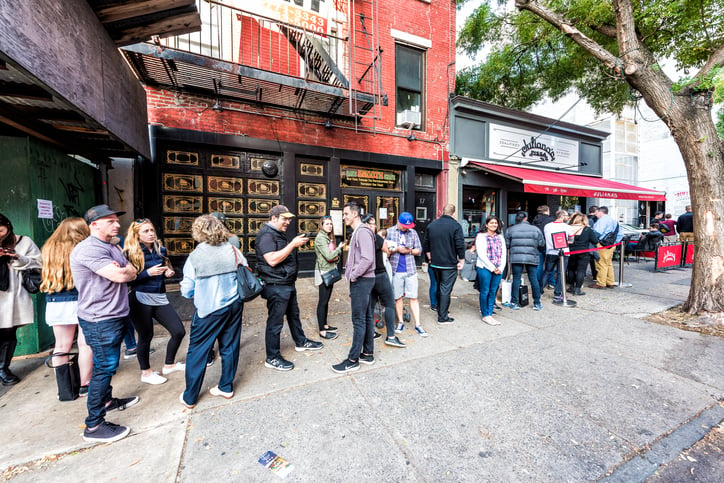Behind every great bar is a great bartender. Behind them, is a bar business plan that sets your establishment up for a successful launch and long-term success. Whether you’re setting out to open your own spot or expanding into a new neighborhood with another location, your first step is laying out your plan. An effective bar restaurant business plan covers everything from financial goals to local business marketing strategies, all detailed in this 6-step guide.
1. Executive summary
A well-constructed bar business plan can be your roadmap, helping guide and establish your business’s operations and reputation. Not only is it an essential document if you’re raising funds, but it’s also a helpful way to organize thoughts and plans for yourself and to share them with employees.
Start every business plan with a summary to hook the reader to learn more about your company and your proposal. Think of it a little like a sales pitch for your bar, and a preview of everything you lay out inside your business plan. Be sure to include:
- Mission statement – Be both ambitious and realistic with how you position yourself and your bar with a mission that answers the question, “who are you and what do you do?” This should touch on why you’re opening this business and what you hope to accomplish in doing so.
- Concept – Whether you picture your bar as a high-end cocktail lounge or a family-friendly brewery, share what will make your place unique. Get specific on how it will compete in the neighborhood you’re opening in, touching on the local demographic and other establishments.
- Operations – Briefly summarize how your business will function, whether you’ll be open late, serving food, or offering a retail selection. Detail the general structure of owners, managers, and employees.
- Value propositions - Highlight the value of your bar and what sets it apart from others in the area. Turning her food truck Yolos into a brick-and-mortar location, in Amarillo, TX, restaurant owner Yolanda Grazier offers an escape for the local lunch crowd: “We're really hoping to bring a good place where people are comfortable to come and sit down, enjoy a meal with their coworkers, [and] get a little rest and relaxation before they go back to work.”
You can also include your experience, industry trends, and more about the local market to show how your neighborhood bar will meet your goals.
2. Location and design
Your bar’s physical location, inside and out, is important for business and your business plan. Use this section to connect your location to how it will influence your bar’s success. It should be clear to potential investors that you’ve done your research and see what will make it special based on the neighborhood it’s in. Share details on:
- Access to public transit – An accessible location near a bus or metro stop will make it easier for customers to come and go from your bar safely.
- Neighborhood – Location may influence the type of bar you open, and vice versa. Share more about the area you’re located in and how you’re filling a need there. You can include what kind of foot traffic your location gets and demographic information of clientele, like age, income, lifestyle details, and employment information.
- Interior design – From the back bar to your floor plan, establish plans for what your bar will look like inside. Include diagrams and renderings that will illustrate your vision. List amenities, like kitchen appliances and bathroom, plus any plans for remodeling.
3. Inventory and menu planning
Whether you’re serving local craft beer or a selection of wine from around the world, this is your opportunity to get specific about what neighbors at your bar will be saying “cheers!” with.
Include inventory needs and menu planning details, like:
- Menu options – The more details you can provide about your upcoming specialties, the better. Share your menu, with price points and seasonal variations, as well as plating and glassware.
- Ingredient lists – Provide the ingredients you plan to use and where you’ll source them. Share distributors for liquor, beer, and wine, and don’t forget mixers and garnishes.
- Miscellaneous items – Bar napkins, glassware, straws, cleaning supplies, and towels are necessary for most bars. Estimate weekly ordering needs and identify suppliers to ensure everything is accounted for.
Since the investors, lenders, or partners reviewing your bar business plan may not have the opportunity to test everything on your future menu, get detailed on flavor profiles, tasting notes, and descriptions to help them preview the experience of ordering at your bar.
4. Research and marketing strategy
To build buzz for your local bar or restaurant, try a mix of traditional print advertising and online marketing. Get to know your local and target demographics to decide where and how to reach them.
In the marketing section of your bar business plan, provide details on:
- Demographics - Are you near a university, a hospital, or a hotel? Include neighborhood demographics and how you plan to serve locals what they’re thirsty for. With 22.9% of bar revenue coming from customers between the ages of 21 and 34, age and income level can be factors worth highlighting.
- Neighborhood specifics - Tap into the interests and needs of the community you’re opening your doors in Speak directly with your bar’s new neighbors and connect with fellow businesses with a free Nextdoor business page that gives you instant access to everyone within two miles.
- Traditional and digital marketing – Share your marketing plans, which should consider industry trends, print, and local advertising, partnering with other local businesses, and building a digital presence. Your bar should have a website, Nextdoor business page, and other social media so your information is readily available, easily searchable, and stands out as neighbors scroll for where to go this weekend.
Make marketing more effective by keeping both larger industry trends and your local demographic in mind as you plan to drive and build awareness for your bar.
5. Financial plan
The financial section of your bar business plan covers your financial history with potential for profit and your plan for obstacles that may come up. This is important for your business strategy, as well as for potential lenders, investors, or partners to see.
Develop your bar’s financial plan with information on the following:
- Overhead costs – Price out liquor licenses, business licenses, and any associated fees with starting your bar restaurant. Note any equipment or training required to open.
- Financial projections – Estimate your cash flow and the revenue for the first few years of your business, sharing when you expect your bar to break even.
- Capital investment – Note your inventory, staff, and real estate costs, plus taxes and insurance costs. Assess what type of funding you need, if any, and what you’ll do with — and how you’ll pay back — any investment. Note any money that is set aside to cover unexpected fees and incidentals.
If you have unique plans to drive additional revenue, include them here in the financial section. Pa-Nash Restaurant, Bar & Lounge in Queens, NY, found new opportunities in catering and deliveries. Event buyouts or private dining options could be a secondary way for your bar to make money.
Consider hiring experts, like an accountant, to help you with this stage of the process, especially if they have advised other local bars or restaurants in your area.
6. Daily operations
Any potential investors or partners will need to get a sense of your day-to-day operations. Even if you change specific details once your bar is open, going in with an idea can make your first weeks easier for you and your team.
Daily operations for a bar owner can include:
- Service style – Whether you’re opening a smaller bar with a single rail or a massive bar restaurant with tables and servers, explain how service will run. Detail and define POS systems, tickets, and customer comps.
- Chain of command – Delineate staff responsibilities, as well as the general chain of command for managers and operators. Everyone should know their exact role and responsibilities when they walk into work each day.
- Company policies – Sick leave, paid time off, and general company policies can be established in this section. Consider creating a separate employee handbook for easy reference as you onboard team members.
Even a busy bar can feel like a well-oiled machine if its daily operations are established on day one. Prepare for success and help eliminate unnecessary stress when your bar finally opens its doors.
Open shop on Nextdoor
An effective bar business plan will help guide you on the path toward success. As a local establishment, another key element to a bright future for your bar is in making it a neighborhood favorite. With one in three households on Nextdoor, there are potential customers right around the corner who can help. Invite neighbors in when you claim your free Nextdoor Business Page. Build buzz for your opening, share local deals, and give your neighborhood something to cheers to.








